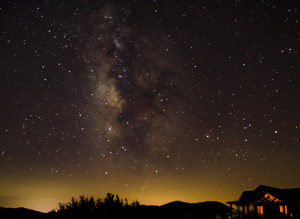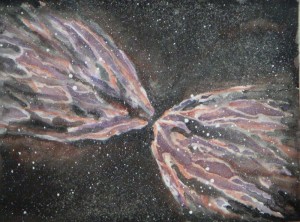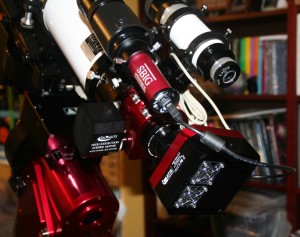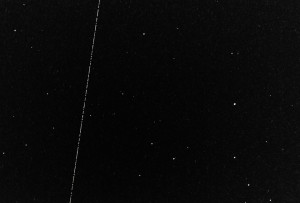Wednesday night August 12th was a great night for viewing Perseid meteors. The promise of a near new moon, and finally a clear night, had me eager with anticipation as I headed into the North Carolina Mounatins for the evening. The air above Grassland Mountain in Marshall, NC was chilly, but clear. The Grassland Observatory owned and operated by the Astronomy club of Asheville hosted the observing event for members and their guests. There were about 4 dozen of us in and around the big roll off roof observatory. Early in the evening many of us gathered around the 16” SCT and viewed some familiar favorites like Saturn, M13 and M92, and later on the Double cluster (one at a time in the SCT), Uranus and some double stars.
After a while many of us found our way to blankets and lawn chairs to settle in for what turned out to be a spectacular night for observing meteors. As the Milky arched above, nearly horizon to horizon, we watched dozens of meteors streak across the sky. More than a dozen made long arcs over 25 degrees in length, and blazed brighter than Venus at its best. There were even a couple of fireballs which left twisted trains of smoke and broke apart as they disappeared. One interesting note is the sighting of several meteors that seemed to originate form a similar point in the south, perhaps from another minor meteor stream. I know there are a couple of active ones at this time. I should have been more focused to determine their origin.
A few of us had binoculars with so I gave a little impromptu guided tour of some of the Summer clusters across the sky. We started at easy to find stars and then using the “clock” to move field by field to some Summer highlights. It had been a while since I’d done much visual observing with binoculars, so I stuck to the more familiar objects I could easily locate and direct people to. Some of the objects we viewed were M52, M34, M39, the Coathanger, Andromeda Galaxy, M33, the Double Cluster, The Perseus Stellar association by Mirfak, M22, M24 and one of my favorites NGC 7789. This object was more of a challenge for some to see its soft glow among the stars of Cassiopeia. We were even able to make out the North American Nebula and Gulf of Mexico. Its neighbor the Pelican Nebula was faintly visible as well.
My intention that evening was to take some wide field images of constellations, hoping to capture a meteor or two, but technical difficulties got in the way. I probably enjoyed the evening more, not having to tend to a camera all night. One of my friends, Alan Davis, was also imaging and caught some nice Milky Way views, but no meteors. He took the image of the southern Milky Way, with the lodge at the top of the mountain in the background. There is sky glow at the horizon, but visually it wasn’t as obtrusive as the image might indicate. In fact, it was one of the best views I’ve had of our galaxy stretching across the heavens. Most of the time the star fields look like hazy cirrus clouds in the sky. That night they looked like storm clouds. The Cygnus arm was very well defined by the dust of the central bar. It was the first time I could see mottled definition in the star fields and the complete outline of the Milky Way, like the way it’s depicted in the charts.
Among the meteor showers I’ve observed this one is second only to the meteor storm of the Leonids in November of 2000. It was definitely worth the nearly two hour trip into the mountains.
Thanks goes to Dominic Lesnar, our club President, for hosting this great night (and for the chocolate chip cookies)!
dw




